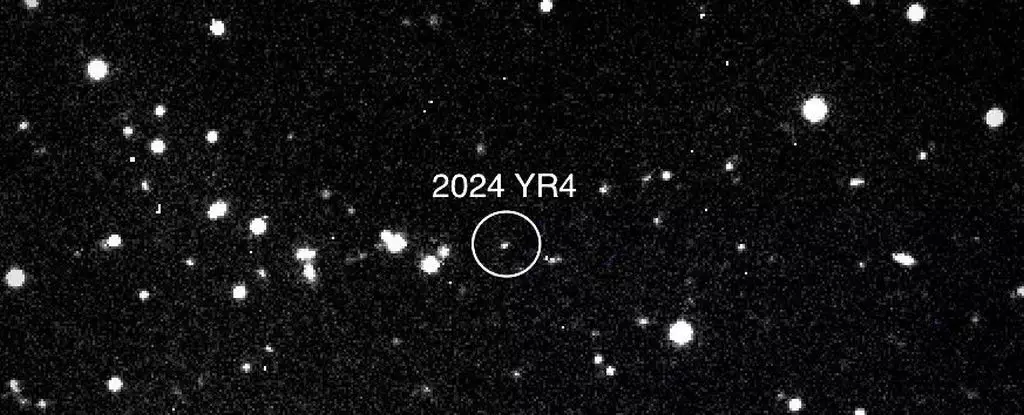Asteroid 2024 YR4, nicknamed the ‘city killer,’ has returned to our collective consciousness, sparking fears and intrigue about its future trajectory. While it’s customary for such celestial bodies to capture the public’s imagination, the persistent whispers surrounding YR4 are a testament to our complicated relationship with the cosmos. Presently, scientists assure us that the odds of this asteroid colliding with Earth are minuscule, standing at a mere 0.001 percent. Still, that reassurance offers little comfort in an age increasingly dominated by existential threats—both terrestrial and extraterrestrial.
In December 2032, YR4 is poised to make a notable approach to Earth, raising questions not just for our planet but also concerning the Moon. According to a report from a team led by planetary astronomer Andrew Rivkin of Johns Hopkins University, YR4 has a non-negligible chance of impacting the Moon during its close flyby. The fact that the Moon could potentially bear the brunt of an asteroid impact only heightens the stakes. The inexplicable relationship between humanity and celestial objects has never been more apparent. Navigating this precarious dance between awe and anxiety is a nuanced challenge.
The Elusive Data and What It Means for Humanity
Up until recently, uncertainty surrounding the asteroid’s prediction had scientists scrambling for clarity. Initially, projections placed the probability of a significant impact at around 3.1 percent—still relatively low but alarming enough to warrant close attention. The vast unknowns of deep space can induce a shared anxiety; even a small chance can feel insurmountable when the implications are so grave. The emotional weight of contemplating the potential devastation that might arise from an asteroid impact reveals a deeply human instinct to fear the unknown.
Currently, considerable efforts are being directed toward gaining observational insights about YR4, including imminent observations planned for the JWST in May 2025. These measurements will continue to enhance our understanding of the asteroid’s composition, trajectory, and reflecting properties. The significance of such studies cannot be overstated; they may provide the necessary tools for risk assessment, especially since impacts could range from an energy release equivalent to a small atomic bomb to devastating effects akin to significant natural disasters. Our ability to predict and prepare for celestial dangers hinges on knowledge and data—an irony not lost in our current era of misinformation.
The Universe’s Crude Reminder
2024 YR4 serves as a stark reminder of how precariously balanced our existence is within the cosmos. Its discovery in December 2024 sent shockwaves through the scientific community, igniting fears of extensive damage if it veered off its calculated course. However, the subsequent easing of threat levels allows us to temporarily breathe easier. This evolving narrative reflects not just on the nature of space exploration but also on how humanity grapples with life’s uncertainties. Availability of information must accompany frameworks for understanding these phenomena, fostering a sense of resilience within a landscape fraught with unpredictability.
Far from being a simple rock hurtling through space, YR4 has become a canvas for our collective hopes and fears. The scientific community’s relentless monitoring of the asteroid demonstrates our quest for certainty in a reality that frequently escapes our grasp. People remain captivated by the notion that we still have so much to learn about our universe, and the pressing need for research in the realm of astrophysics feels stronger than ever.
Coping with Cosmic Uncertainty
As YR4 becomes a focal point for ongoing research, we must grapple with the existential questions it raises. While we can take solace in current safety assessments, an underlying anxiety inevitably lingers. The increasing frequency of asteroid discoveries urges humanity to take a more proactive stance towards space safety and disaster preparedness. Yet, the challenge lies not only in understanding these celestial bodies but also in how we communicate potential threats to the public. Misinformation can easily cultivate unnecessary panic, distorting our perceptions of the natural marvels that surround us.
Ultimately, the fate of 2024 YR4 remains unwritten—an endless loop of investigation and speculation. Humanity must strike a delicate balance between curiosity and caution, reminding ourselves that while the universe teems with dangers, it also beckons with the promise of discovery. Our capacity for exploration, resilience, and adaptability will be as crucial in the face of uncertainties like YR4 as it is in addressing the myriad challenges impeding our progress here on Earth. The quest for knowledge, while daunting, shines as a beacon of hope in our shared cosmic journey.


Leave a Reply